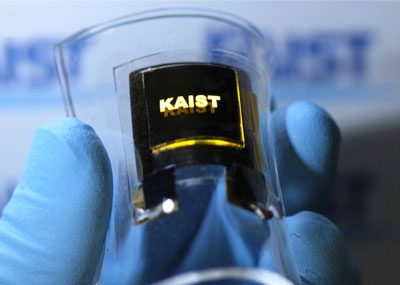| Posted: Aug 07, 2012 | |
First prototype of a fully functional all-flexible electronic system (w/video) |
|
| (Nanowerk Spotlight) High-performance flexible power sources have gained attention as they enable the realization of next-generation bendable, implantable, and wearable electronic systems. Numerous approaches to fabricate flexible energy sources have been developed, ranging from various designs for transparent electrodes (see for instance: "A highly efficient method for creating flexible, transparent electrodes") to entire nanogenerators for self-powered devices and systems. | |
| In the past, researchers have tried to design flexible batteries with compliant materials in order to enhance the mechanical flexibility such as organic materials or nano/micro structured inorganic materials mixed with polymer binders. However, these organic materials have a low specific power density due to binder space and they generally have shown low performance for operating flexible devices such as bendable displays. | |
| "Although the rechargeable lithium-ion battery (LIB) has been regarded as a strong candidate for a high-performance flexible energy source, compliant electrodes for bendable LIBs are restricted to only a few materials – e.g., organic materials or nano/micro structured inorganic materials mixed with polymer binders – and their performance has not been sufficient for them to be applied to flexible consumer electronics including rollable displays," Keon Jae Lee, a professor in the Department of Materials Science and Engineering, Flexible and Nano-bio-energy Device Lab, at Korea Advanced Institute of Science and Technology (KAIST), explains to Nanowerk. | |
| An additional complication arises from the fact that lithium transition metal oxides used as a cathode electrode have to be treated in high temperature (e.g., ∼700 degrees for lithium cobalt oxide). However, it is not possible to thermo-treat the active material on flexible substrates like polymer materials. | |
| In a new study, Lee and his team have fabricated an all-solid-state bendable LIB structured with high-density inorganic thin films using a new universal transfer approach, which enables the realization of diverse flexible LIBs regardless of electrode chemistry. Moreover it can form high-temperature annealed electrodes on polymer substrates for high-performance LIBs. | |
| As they reported in the July 30, 2012, online edition of Nano Letters ("Bendable Inorganic Thin-Film Battery for Fully Flexible Electronic Systems"), the team's thin-film LIB is capable of a maximum 4.2 V charging voltage and 106 µAh/cm2 capacity, which indicate the highest performance ever achieved for flexible LIBs. | |
| In their work, the researchers developed a transfer approach using mica substrate delamination, which enables the highly crystalline lithium cobalt oxide (LiCoO2) cathode thin-film from high-temperature annealing (>700°C) for high-performance LIBs to be utilized on flexible polymer substrates. | |
| "We would like to emphasize that solid state thin-film battery has been developed for quite a long time and commercialized for various applications," says Lee. "Our achievement is not the development of a thin-film battery but focused on the development of a flexible thin-film battery using a transfer protocol for the ultra-thin battery film itself – withless than 10µm thickness." | |
| The team notes that this bendable LIB enables the fabrication of an all-in-one flexible LED display integrated with a bendable energy source, which provides an innovative platform for the next-generation flexible electronic system. | |
| "Our novel transfer approach can be expanded to various high-performance flexible applications, such as thin-film nanogenerators, thin-film transistors, and thermoelectric devices," says Lee. | |
| To demonstrated the feasibility of their flexible battery, the researchers integrated a high-performance bendable thin-film LIB into a flexible LED display system on a plastic substrate. | |
 |
|
| Picture of an all-in-one flexible LED system integrated with a bendable LIB (Photo: Dr. Lee, KAIST) | |
| "As far as we know, this is the first prototype of a fully functional all-flexible electronic system" says Lee. | |
| The current fabrication technique has limitations, though. Although this study shows the possibility of an all-solid-state thin-film LIB as a high performance flexible battery, the current process requires that the mica substrate is manually, piece by piece, delaminated by sticky tapes over the course of 10 minutes. | |
| However, Lee and his team are already investigating a laser lift-off process instead of the sticky-tape delamination to facilitate mass production of large area flexible LIBs. The feasibility of this process has already been demonstrated and it will be reported in an upcoming paper. | |
| A flexible battery like the one described here enables the realization of diverse flexible LIBs applications regardless of electrode chemistry. Obviously, as Lee points out, industrial applications would be focused on energy source for flexible display system such as e-paper or rollable displays. Further down the road are more sophisticated wearable (on the skin) and implantable devices. | |
| This video demonstrates the bendable LIB and its integration into a working, all-flexible electronic system: | |
 By
Michael
Berger
– Michael is author of three books by the Royal Society of Chemistry:
Nano-Society: Pushing the Boundaries of Technology,
Nanotechnology: The Future is Tiny, and
Nanoengineering: The Skills and Tools Making Technology Invisible
Copyright ©
Nanowerk LLC
By
Michael
Berger
– Michael is author of three books by the Royal Society of Chemistry:
Nano-Society: Pushing the Boundaries of Technology,
Nanotechnology: The Future is Tiny, and
Nanoengineering: The Skills and Tools Making Technology Invisible
Copyright ©
Nanowerk LLC
|
|
|
Become a Spotlight guest author! Join our large and growing group of guest contributors. Have you just published a scientific paper or have other exciting developments to share with the nanotechnology community? Here is how to publish on nanowerk.com. |
|
